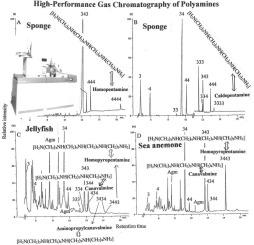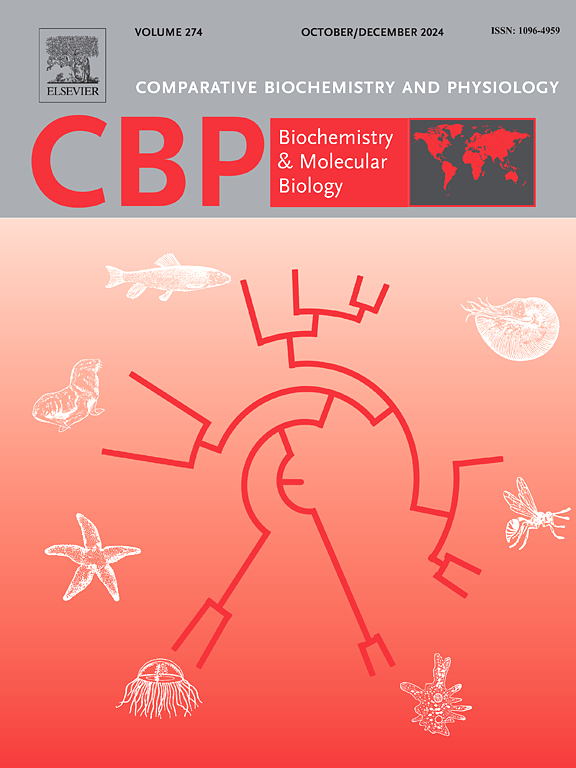Polyamine distributions in invertebrates VI: Comparative cellular polyamine analysis of unicellular choanoflagellates and multicellular sponges, comb jellies, hydras, jellyfishes, sea anemones and soft corals
IF 1.8
3区 生物学
Q4 BIOCHEMISTRY & MOLECULAR BIOLOGY
Comparative Biochemistry and Physiology B-Biochemistry & Molecular Biology
Pub Date : 2025-08-05
DOI:10.1016/j.cbpb.2025.111141
引用次数: 0
Abstract
The more than 35 described biogenic polyamines have important roles in physiological processes ranging from acid-base buffering to the scavenging of oxygen free radicals. As such they have key cellular- and organismal-level functions in environmental adaptation, cell growth, cell differentiation, fertilization, and biomineralization. To determine cellular polyamine distribution profiles in animals at the base of the phylogenetic tree, the acid-extracted polyamines from cultured cells of a unicellular choanoflagellate and whole bodies of five multicellular invertebrate groups (total 20 species) were quantitatively analyzed using high-performance liquid chromatography and high-performance gas chromatography. Both the choanoflagellate and hydra contained putrescine and spermidine. Diaminopropane, putrescine, cadaverine, norspermidine, spermidine, homospermidine, norspermine, spermine, thermospermine and agmatine were commonly identified among the other invertebrates. In unusual/rare polyamines, aminopropylhomospermidine, homospermine, caldopentamine and homopentamine were found in sponges; aminopropylhomospermidine and canavalmine in the comb jelly; canavalmine, aminopropylcanavalmine and homopyropentamine in jellyfishes; and canavalmine and homopyropentamine in sea anemones. However, long-chain polyamines were not found in soft corals.

多胺在无脊椎动物中的分布VI:单细胞长鞭毛虫和多细胞海绵、栉水母、水螅、水母、海葵和软珊瑚的细胞多胺比较分析。
超过35种描述的生物源多胺在生理过程中发挥重要作用,从酸碱缓冲到清除氧自由基。因此,它们在环境适应、细胞生长、细胞分化、受精和生物矿化方面具有关键的细胞和有机体水平的功能。为了确定动物细胞多胺在系统发育树底部的分布特征,我们使用高效液相色谱和高效气相色谱对单细胞鞭毛动物和5个多细胞无脊椎动物群(共20种)的培养细胞中酸提取的多胺进行了定量分析。尾鞭毛虫和水螅均含有腐胺和亚精胺。二氨基丙烷、腐胺、尸胺、去亚精胺、亚精胺、同亚精胺、去精胺、精胺、热精胺和精氨酸在其他无脊椎动物中普遍存在。在异常/稀有多胺中,海绵中检出了氨基丙基同精胺、同精胺、钙多巴胺和同精胺;蜂胶中的氨基丙基同亚精胺和犬avalmine;水母中的鼠尾草碱、氨基丙基鼠尾草碱和同丙戊胺;还有海葵中的鸭avalmine和homopoppentamine。然而,在软珊瑚中并没有发现长链多胺。
本文章由计算机程序翻译,如有差异,请以英文原文为准。
求助全文
约1分钟内获得全文
求助全文
来源期刊
CiteScore
4.60
自引率
4.50%
发文量
77
审稿时长
22 days
期刊介绍:
Comparative Biochemistry & Physiology (CBP) publishes papers in comparative, environmental and evolutionary physiology.
Part B: Biochemical and Molecular Biology (CBPB), focuses on biochemical physiology, primarily bioenergetics/energy metabolism, cell biology, cellular stress responses, enzymology, intermediary metabolism, macromolecular structure and function, gene regulation, evolutionary genetics. Most studies focus on biochemical or molecular analyses that have clear ramifications for physiological processes.

 求助内容:
求助内容: 应助结果提醒方式:
应助结果提醒方式:


